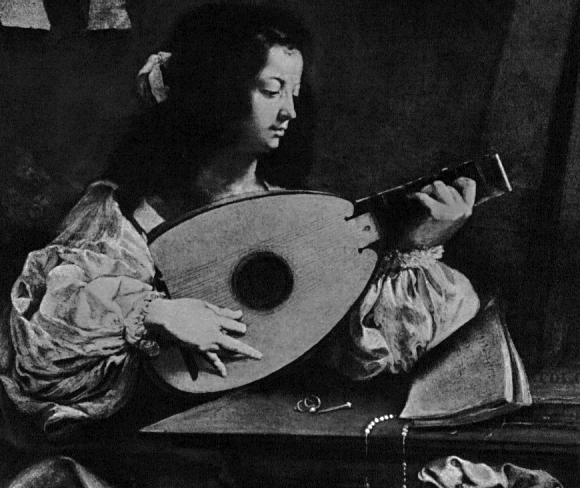
My Historical Performance Practices
Gut Strings
I string my Lutes only in Historical Gut. Although this practice is gaining more popularity as of late, it is still, a very rare thing to find a lutenist using all Gut on their instruments. There is no comparison between the timbre, warmth and relenting fragility that only gut can capture, Vs. plastic, carbon polymers, wound metals and other synthetics. I do freely admit, that I am unreasonably fanatical about historical gut strings.

Lutes & Tables

As a Lutenist, I employ one of the most important, but virtually completely forgotten historical performance practice in Lute Playing and in all Renaissance and Early Baroque music-making. This is the practice of playing lutes and other instruments on The Table, or at least reading their music from The Table. The Table was the Centerpiece of Social and Musical life in the Renaissance and early Baroque.
In the Renaissance and Baroque periods, the table was much more than just an object to to place their keys or pizza boxes. In the 15th-18th centuries (especially the 16th), the table was the center of social and musical life. A piece of furniture so simple that we, in our century and society, take for granted. In times past, the table was a center-piece for activities well beyond the convivial consumption of food.
Certainly, the lute is very portable instrument, and was likeley performed without touching a table as often as with touching or upon a table. Research has shown that lutenists in the Renaissance and Early Baroque prefered table playing whenever possible.
Table playing provides the performer a flat "music desk" so that the sound & aesthetic beauty of the instrument is not obstructed. Today, we see so many historical instrument performers behind these enourmous black metallic orchestral music stands that serve to obstruct the "line of sight" (Sound) from the rosette to the listener.
The table also acts as a resonator. The Lute sounds wonderful on its own, but add the table, and the result is something to behold. The timbre, depth and warmth that Table playing provides is significant. The table also teaches the the lute player better posture resulting in more efficient execution of tone and technique.
Thomas Robinson, Thomas Mace, Marin Mersenne, Ernst Gottlieb Baron have written very clearly about this practice. There is also the somewhat famous account of Francesco da Milano "choosing a table to seek out a Fantasy" before a performance. Other evidence that we find is in the table-book format that we see in the vast English Lute Song and consort repertoire. The English Lute Song prints often had up to 5 singing parts with the lute accompaniment and was printed for the musicians to read from one book, around a table, as the music was printed in 4 directions to be read by as many sometimes plus 2 people around the table. In Louvain in 1568, the printer Pierre Phalèse published lute duets in his Luculentum theatrummusicum with parts situated in a manner so that the lutenists could face each other and play across the table. We see the same format in the Lute duets of Thomas Robinson from his School of Mvsicke 1603.
There is so much more to be presented on this subject, soon I shall provide a link to a blog, where one will find many more details, footnotes, and historical pictures depicting how important the table was historically in lute playing and all music making in the Renaissance and Baroque.










Historical Temperments
The Lute, and many other historical string instruments can be adjusted in order to accomodate historical temperments, simply by moving the frets.
Depending upon the repertoire, or even the kay of the piece, one can adjust the temperament by moving the Lute frets to a specific calculated distance from the nut to the fret. I usually use 1/6 comma meantone or 1/4 comma meantone. There
are other variants to these temperments that I sometimes explore,
but most of the time I am performing in 1/6 comma meantone.

Lighter stringing and fretting
I string my Lutes using slightly lighter gauges of gut than is commonly accepted. In my experimants, I have discovered that lighter string tension brings more of the tonal nuances of the lute than at higher tensions. The "pop" and "bounce" is not sacrificed in pieces of a spritely nature. Too much tension, chokes the life out of the instrument.

The frets are also, very important. In the last 40 years or so, the conventional wisdom was that one should fret their lutes, historical guitars, and viols with the largest possible frets, just before string buzzing would occur. I have discovered that this is simply not the way to fret lutes & other historical fretted instruments. John Dowland describes using a fret size that begins with the first fret being the size of the first string, and presumably grading down in size the farther up the neck. This sizing seems to be exceedingly small and we are not sure if we can take Dowland's description as Gospel. However, with frets that are too large, the first thing that happens is that when you play a note or a chord, the distance between the contact point of the strings bottom to the fretboard bends the notes out of tune. It is actually more difficult to play with larger than with smaller frets. Smaller frets allow the performer smoother movement from note to note & chord to chord. It is a balancing act of sorts, somewhere in the middle of very large and very small frets, lies reality.
